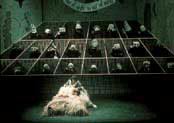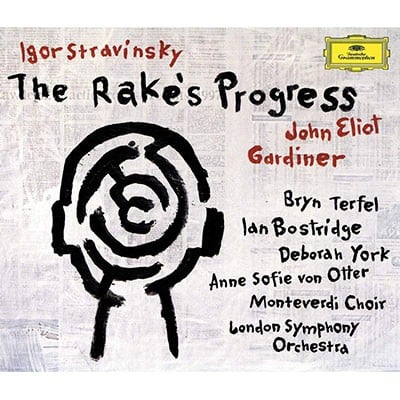OPERA SEARCH

The Rake's Progress
(1948-51)Libretto by W H Auden and Chester Kallman (E,Cz,F,G,I)
Major roles: lyrS,dramM,hT,Bar; minor roles: A,T,2B; chorus
2(II=picc).2(II=corA).2.2-2.2.0.0-timp.perc:offstage bell/cuckoo-hpd(or pft)-strings
Abbreviations (PDF)
Boosey & Hawkes
Teatro la Fenice, Venice
Carl Ebert, dir / Nicola Benois, prod
Conductor: Igor Stravinsky
Company: Chorus and Orchestra of the Teatro alla Scala, Milan
| TRULOVE | Baß |
| ANNE TRULOVE, seine Tochter | Lyrischer Sopran |
| TOM RAKEWELL, ihr Liebling | Hoher Tenor |
| NICK SHADOW | Bariton |
| MUTTER GOOSE, Bordellbesitzerin | Alt |
| BABA, genannt die Türkenbaba, bärtige Dame | Dramatischer Mezzosopran |
| SELLEM, Auktionator | Tenor |
| Ein Wärter des Irrenhauses | Baß |
| Dirnen und grölende Burschen, Diener, Bürger, Irre |
England, 18. Jahrhundert
In einer idyllischen Gegend auf dem Land feiern Anne Trulove und Tom Rakewell ihre Liebe. Annes Vater hat für Tom Arbeit in der Stadt gefunden, doch Tom will leichter zu Geld kommen. Nick Shadow kommt mit der Nachricht, daß Tom ein Vermögen von einem unbekannten Onkel geerbt hat. Sie müssen nach London aufbrechen, und Tom muß Shadow für seine Dienste erst nach einem Jahr und einem Tag bezahlen. In der bösen Stadt zeigt Shadow ihm Mutter Gooses Bordell. Auf dem Land befürchtet Anne derweil das Schlimmste und beschließt, Tom zu retten.
Tom ist in seinem neuen Londoner Haus seiner gewöhnlichen Vergnügungen schon überdrüssig, also schlägt Shadow ihm vor, die erstaunliche bärtige Türkin Baba zu besuchen. Als Anne in Toms Haus eintrifft, muß sie zu ihrem Entsetzen entdecken, daß er mit der gräßlichen Baba verheiratet ist. Bald hat Tom auch von Baba genug. Noch einmal lockt ihn Shadow mit einer neuen Idee: einer Maschine, die Steine zu Brot macht. Anne versucht erneut Tom zu retten, doch dieses Mal steht sein Haus zum Verkauf und sein Besitz wird zur Versteigerung angeboten. Tom, vollkommen ruiniert, ist mit Shadow fortgegangen. Baba drängt Anne, ihm zu folgen.
Ein Jahr und einen Tag nach ihrer ersten Begegnung führt Shadow Tom des Nachts auf einen Friedhof. Voller Schrecken wird Tom klar, daß er nicht mit Geld, sondern mit seiner Seele bezahlen muß. Doch als Shadow ihn packen will, hört Tom Annes Stimme aus der Ferne, und seine frühere Liebe erwacht. Shadow ist besiegt und verschwindet im Boden. Tom überlebt, doch verliert er seinen Verstand und wird ins Irrenhaus eingeliefert. Anne besucht ihn, um ihn zu trösten, doch kann sie nicht mehr viel ausrichten. Ihr Vater überredet sie, Tom seinem Schicksal zu überlassen.
Stravinsky’s largest work, his only full-length work for the theatre, and his first major work in English. It also represents the culmination of his neoclassical years, after which he started to rethink his musical language. The idea was prompted by seeing an exhibition in Chicago in 1947 of a series of Hogarth prints and he instantly recognized their operatic potential. The depiction of the ironic progress of the spendthrift heir of a miser from wealth via debt to madness and death is, in essence, retained in the opera. Stravinsky’s Hollywood neighbour Aldous Huxley suggested he contact the English poet W.H. Auden, resident in New York, to write the scenario and libretto, which Auden did with the assistance of his lover and opera buff Chester Kalmann. The text wittily grafts onto Hogarth’s quest narrative aspects of, among other sources, Classical pastoral, the Faust legend, fairy tale, circus, the Bible and opera in many different manifestations. This is brilliantly matched by Stravinsky’s music, which takes as its source the whole of operatic history from Monteverdi to Verdi via Rossini and Donizetti and large doses of Mozart. Yet it is neither parody nor pastiche; rather, in remaking all of opera into this one new opera, Stravinsky and Auden create a fable appropriate to their modern world: its kaleidoscope of sources speaks of the dislocated, alienated times in which they lived … even if, in a marvellous take on the ending of Don Giovanni, the final epilogue tells us it’s really only a piece of theatre! The Rake’s Progress can be appreciated on many levels, which might explain why it is still one of only a handful of 20th-century operas never to have been out of the repertoire.
Repertoire note by Jonathan Cross
One inspiration for this "moral fable" in "Italian-Mozartian" style ("I will lace each aria into a tight corset") was Hogarth's series tracking the downfall of Tom Rakewell, who squanders his inheritance on women, gambling, and drink and dies in a madhouse. In Auden's much admired libretto, Tom is equipped with a sporadic moral conscience, as well as a satanic alter ego: Nick Shadow. As in Oedipus Rex, man is here a victim of implacable forces that control and crush him. But Anne Trulove, steadfast in devotion, rescues Tom's soul. The pervasive detachment of Stravinsky's score doubles the pathos of Anne's final lullaby.
Repertoire note by Joseph Horowitz
heiter, tragisch

Ian Bostridge/Deborah York/Bryn Terfel/Anne Sofie von Otter/Peter Bronder/Anne Howells/Martin Robson/Julian Clarkson/
Monteverdi Choir/London Symphony Orchestra/John Eliot Gardiner
Deutsche Grammophon 4596482

